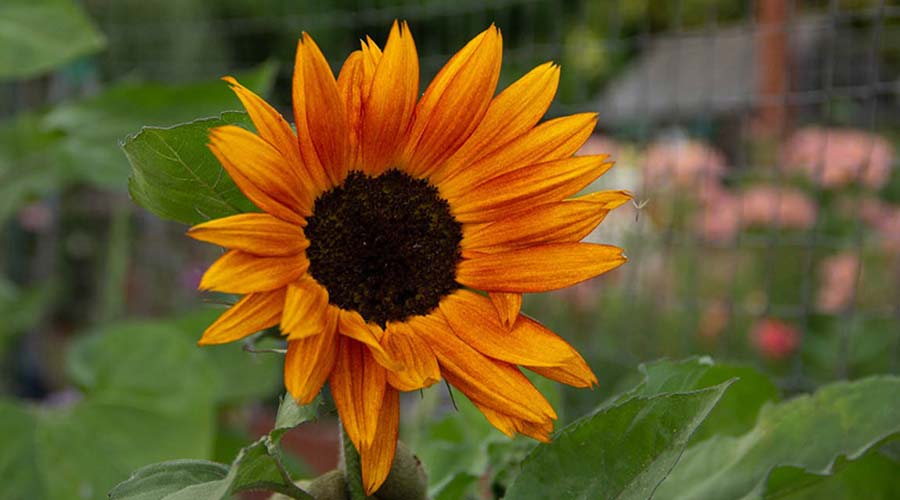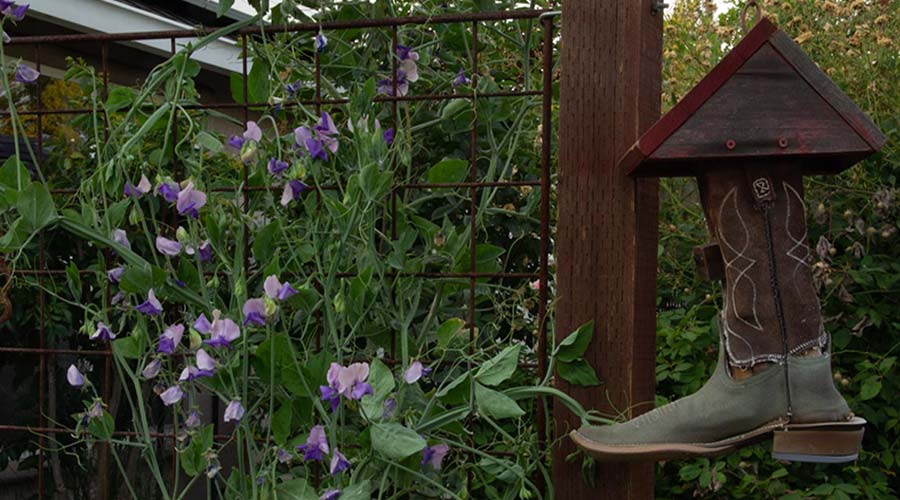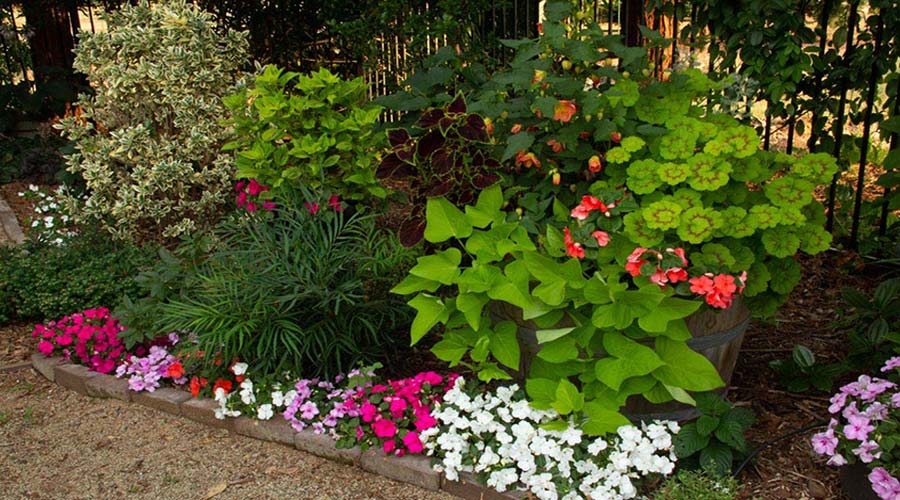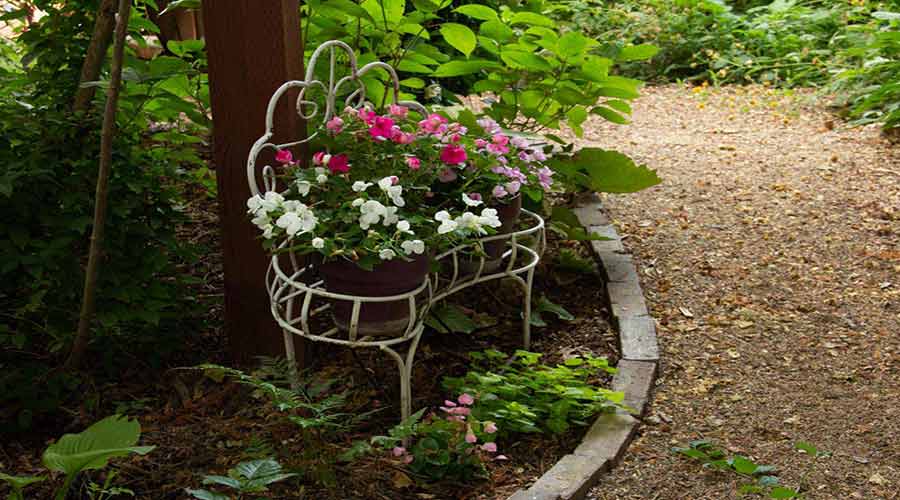Annuals are plants that complete their lifecycle in one year – they grow from seed, flower, die (including the roots), and set seed for the next cycle, all in one year. In contrast perennials live more than 2 years, and their leaves, stems and flowers die back to the ground in autumn, leaving the roots in dormancy. In the spring, the dead parts of the plant are cut back to the ground to reveal the new plant beginning to grow.
Why plant annuals?
Annuals give your garden a spot of quick, vibrant (or subtle) color, particularly if you plant them in groups or masses. You do need to replant every year, but that gives you an opportunity to easily change the variety of annual for those “pockets of color” in your garden! We hosted a wedding and reception for friends in our garden in May (Mother’s Day weekend). I planted annuals to add some quick color to make the garden “pop”!

You don’t want to grow annuals from seed yourself? Or don’t have time?
No problem! It happens to me a lot. Your local nursery carries many different varieties of annuals in jumbo (six-pack) containers, 4” containers or 1 gallon containers. The jumbo pack containers will always be the most economical way to go. However, if you want a quick burst of color in your garden, and can pay a little more, choose the annual in the larger container sizes. The roots of the plants will be more developed and the plant will already have flowers. Voila! Instant color!!

Time needed to manage annuals?
It is best to keep annuals “dead-headed” to continue the bloom and discourage setting seed. Dead-heading is as simple as removing the flower as it finishes blooming. If you want to collect some seed for next year, wait until later in the summer or fall and stop “dead-heading”.
Summer to Fall favorites of mine (grown in full sun garden locations):
- Zinnias – I like all the varieties, and use shorter mounding ones, like zinnia augustfolia in the front of a border, and the Benary Giant hybrid series which grow to 3-4 feet tall toward the back of the border. All are great cut flowers.
- Marigolds – again shorter varieties used for edging with colors from yellow to orange to red to brown; to the tall (3-4’) Crackerjack series, in yellow or orange. All are great for cut flowers.
- Lobelia and alyssum – good edging color (blues, white, pink, lavender).
- Gomphrena – also known as globe amaranth – mound shaped plants in red, pink, white, and purple. I love Gomphrena “buddy purple” to use in flower arrangements as a filler.
- Helianthus – commonly known as sunflowers! Who doesn’t love sunflowers? And they are no longer just big yellow flowers with a brown center! They grow from 24 inches to 12 feet, depending on the variety. Colors range from cream to white to yellow, to red, to orange, to almost brown, and bicolors. And a fun cut flower. Do you see a pattern here? I choose most flowering plants because they are good cut flowers, too.
- Cosmos – great daisy-like flowers and lacy filigree-style leaves. Most cosmos are available in colors of white, light pink and dark pink and in heights from 1 ½’ to 5’. This is another flower I like for cutting.
- Vinca – Catharanthus roseus, is the annual vinca, not to be confused with the perennial vinca which is commonly called periwinkle. Annual vinca grows to about 1 ½ feet tall, likes full to partial sun, with a compact habit that is great in a border. Vinca comes in a variety of colors – reds, pinks, white, and lavender. It blooms from spring through fall to the first freeze. For me, that might not be until November or even December. This is the exception top my rule: It is NOT for cutting.
Winter to Spring favorites of mine:
- Viola – great to plant over daffodil and tulip bulbs for a “carpet” of color under flowering bulbs! Violas come in all colors, including blue. The flower is also edible.
- Pansy – All colors including shades of blue and bicolors, great in borders or pots, also edible.
- Sweet Pea – climbing varieties that need a supporting framework (trellis, cage, pole, or another plant) are one of my favorite cut flowers; most are fragrant and they come in all colors. Keep them picked to keep them blooming. You can also let the flowers mature to a crispy pod and collect the seeds.
- Primula – aka Primrose – The most common variety, “polyanthuis”, is mounding 6-12” tall and comes in all colors. “Obconica” series has larger flowers on long, hairy stems (which can cause skin rash!) “Malacoides”, or Fairy Primrose has 6-8” stems. All are great in borders and pots.
Favorite summer annuals with sun varying from morning only to shady most of the day
- Impatiens – aka bizzy lizzy. Great mounds of color in early summer to Fall; white, shades of red, pink, orange, lavender, and bicolors
- Nigella – aka Love in a Mist. Favorite colors are pink, blue, and white. Nigella self-sows easily and seed heads make a great dried flower for arrangements.
- Coleus – Grown primarily for its colored foliage, although it does flower. It comes in a wide range of colors: green, yellow, chartreuse, orange, red, purple (almost black!), brown, and often with several colors on each leaf. Grows to about 2 feet tall and works well in pots as well as the garden. Coleus roots easily in water if you want to grow more plants yourself. They can be a houseplant in the winter months. Otherwise, they continue performing spring through fall until the first frost. And I have used them in cut flower arrangements, too!

In summary, annuals add extra pizazz to your garden! Don’t leave them out!


